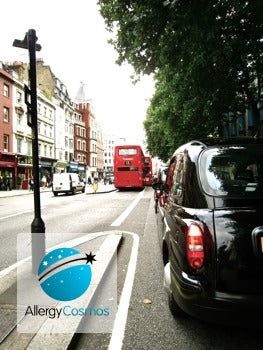Air pollution is usually invisible, and so it is not right away apparent what is in air pollution. You normally only see air pollution when there is a sun set and the atmosphere around it seems dark orange or red, or indoors when it settles as dust or as layers of grime on your furniture and other surfaces.
In fact, air pollution is a complex mixture of liquid droplets, and solid particles, that come in a range of sizes classed as coarse, fine and ultrafine. We get in contact with these tiny particles all the time, indoors and outdoors. Some, like pollen grains, may make their presence felt by irritating your nose and eyes, as in an attack of hay fever. Others, like carbon monoxide molecules, can enter the bloodstream and cause long-term damage to the heart.
So it makes sense to know a bit about what is in air pollution - and the different types of particle pollution - so that you can think about reducing your exposure to them.
Coarse particles. These range in size between 2.5 and 10 micrometres in diameter and include mould spores, which may trigger hay fever and asthma symptoms. The fungus Aspergillus can cause aspergillosis in people with a weakened immune system, the name given to a range of lung infections, ranging from mild to life-threatening. Coarse particles are sometimes known as PM10s. A significant source of PM10s outdoors is traffic pollution. The particles, which are a by-product of combustion, are emitted from vehicle exhausts. PM10s enter the lungs and will exacerbate any existing lung disease, including Chronic Obstructive Pulmonary Disease, and asthma. PM10s are also bad for people with coronary artery disease and heart failure, possibly through causing inflammation. Young children and the elderly are often more vulnerable to many diseases than adults, and the same is true of the health effects of particulate pollution.
Fine particles. These range in size between 2.5 and 1.0 micrometres diameter and include pollen grains or fractions of pollen grains, house dust mite allergen, and pet dander - all of which are key allergens that have long been implicated in asthma and other allergies. The fine particles are known as PM2.5s. They are also bad for those with heart and lung disease and, indeed, may pose even more of a threat than PM10s, because they can penetrate further into the body - as far as the bloodstream - because of their small size.
Ultrafine particles. These are particles with a diameter of less than 0.1 micrometre and would include tiny particles in cigarette smoke and traffic pollution at the molecular level, such as formaldehyde and other Volatile Organic Compounds emitted from various household and DIY products, or carbon monoxide from ill-ventilated boilers or gas cookers. These molecules irritate the throat and lungs and, more seriously, chronic exposure to some of them has been linked to cancer.
If you want to tackle indoor air pollution, an air purifier with a coarse dust filter will trap large and fine particles, but the air purifier will also need to be fitted with an adsorbent HEPA filter such as a HyperHEPA filter to remove those in the ultrafine range (See the range of IQAir air cleaners). To effectively filter out chemical and gases, the air purifier needs to be equiped with an activated carbon filter. Air purifiers such as the Blueair 480i or Blueair 205 combine ionisation with a mechanical mesh filter.
Visit our shop today for the best Air Purifiers for City Pollution.




